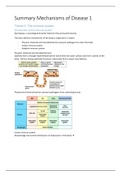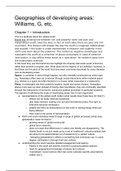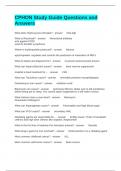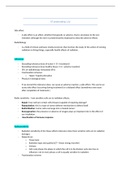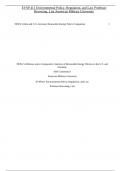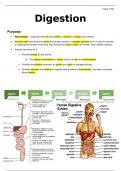LECTURE 1: “Why write about music?”
Musicology is the study of music.
● In other words, music stimulates thought, and is linked to emotion.
Mozart’s “Soave sia il vento” from Cosi fan tutte
Soave sia il vento May the wind be gentle
Tranquilla sia l’onda may the waves be tranquil
Ed ogni elemento and every element
Benigno risponda respond kindly
Ai nostri/vostri desir. to y(our) desire.
The piece elicits a sense of connection and stability–a stable world is projected through
the music.
● It is a trio piece with two female voices and one bass
○ The man is a philosopher, comedian, and ”poet.”
● There is a sort of circular motion interaction between the text/lyrics and the music in
multiple ways.
○ Notably, there is a moment of dissonance in the word “desire.”
● Often, the work of art reflects its creator.
● The background of the work is a farewell prayer by two women.
○ “May the world respond kindly to our desire.”
● EVERYTHING IS A LIE.
○ The man is not going off to war; he is leaving and returning to seduce.
○ As a comedy, everything happens within 24 hours.
○ There is a veil of beauty (or seeing the deformity).
○ Truth and beauty may not always go together.
As performers, you are constantly making choices, be it intentional or instinctive. In other
words, scores always involve choices–interpretation.
● This may include things such as tempo.
● Performance is not only the only form of interpretation–it can take the form of other
works of art, such as visual arts, literature, or film/media (an act of creation).
● Additionally, performance is not a perfect recreation of a score.
● However, there are two exceptions:
○ Jazz, which is always a “new” performance, and
○ Computer-generated music (similar to paintings or movies), which are all
pre-existing and unchanging, with no “performance” aspect.
■ It is “the same performance” no matter how many times you listen to
it.
This begs the question: “When does a performance become its own, new work of art?”
● This shines a light on the difference between composition and realization.
Musical notation is separate from poetry, which directly expresses words and emotions,
allowing for different understandings and interpretations.
, ● It provides instructions for how a piece of music should be performed (e.g., leading
tone on strings, rubato), but a perfect realization is impossible.
● Essentially, notation serves as a blueprint, providing freedom for performers to
interpret the music and add their unique touch.
This is reflected in the phrase “glory of Western music,” which refers to its ability to
accommodate complexity in structures and compositions yet still allowing for the possibility
of “imperfect” replication.
Why is it important to write about music?
● Music is powerful.
○ There is a way of articulating and understanding the boundaries.
● “Music has a technical vocabulary … [a] special difficulty.”
● “Art cannot be taught by formula.”
● Music can be used as a form of self-reflection.
Why write about music?
● To understand, articulate, and communicate thoughts
● As a form of expression and communication
Why do research?
● To reinforce opinions, understand varying perspectives, and become part of a wider
community/conversation with others in the same field(s)
● Note that research is a conversation with peers, as opposed to “vanquishing your
enemies.”
A good thesis is answerable and manageable.
● Avoid should.
● Ensure you are actually arguing something.
○ A thesis is not the same as a topic.
, LECTURE 2: The Elements of Music and the Esprit de Finesse
To interpret music with any authority, you cannot simply proceed by formula–the esprit de
finesse described by Pascal and Barzun is required as well.
Kundera spearheaded the discovery and a non-progressive view of music history.
When describing music history, non-scientific terms (i.e., everyday language and
vocabulary) are used.
● There is often a lack of a perfect definition in terms such as symphony or tragedy.
○ Further, they unfold over time with changing meanings.
● All language about music is metaphorical.
○ Physical “being” is meaningless.
○ Music occurs in a non-material realm.
○ Music is learned through reading and listening, not by formula.
There are often “unknown” similarities.
● For example, there is a 99% genetic overlap between mice and humans.
○ The 1% that sets us apart includes things such as art, language, science, etc.
● Often, music is superficial on the surface.
● Elements/components are not enough for analysis.
○ Identifying an element (e.g., polyphony, sequences) is not enough.
■ E.g., polyphony, sequences
○ You must also observe context, behaviour, and use.
■ The elements are expressive depending on its use.
It is important to differentiate sound and tone.
● Tone requires context.
○ E.g., B on its own vs as scale degree 7 of a C major scale
■ One may say that “it wants to move.”
● However, nothing changes physically.
■ Compare the line “the pitch B is followed by the pitch C” and “the
pitch B resolves to C.” Which says more?
● This is a metaphorical statement–the pitch does not actually
undergo physical movement.
○ “Tone is what makes sound human.”
Timbre is the quality of a sound apart from its pitch.
● E.g., harmonic singing, Bach’s “Ricercar” from The Musical Offering (arr. Webern),
Copland’s “Fanfare for the Modern Man,” Schoeberg’s “Verklärte Nacht”
● It is a fundamental basic of orchestration, and is what gives a piece character.
● It involves overtones, which are physical, measurable qualities (vibrations).
○ The fundamental (base) pitch “gives birth” to additional pitches.
● Scruton suggested that timbre is not as important as pitch, melody, etc.
○ These are important to the character of the piece.
● Varying qualities of instruments lead to different expressive potential.
Musicology is the study of music.
● In other words, music stimulates thought, and is linked to emotion.
Mozart’s “Soave sia il vento” from Cosi fan tutte
Soave sia il vento May the wind be gentle
Tranquilla sia l’onda may the waves be tranquil
Ed ogni elemento and every element
Benigno risponda respond kindly
Ai nostri/vostri desir. to y(our) desire.
The piece elicits a sense of connection and stability–a stable world is projected through
the music.
● It is a trio piece with two female voices and one bass
○ The man is a philosopher, comedian, and ”poet.”
● There is a sort of circular motion interaction between the text/lyrics and the music in
multiple ways.
○ Notably, there is a moment of dissonance in the word “desire.”
● Often, the work of art reflects its creator.
● The background of the work is a farewell prayer by two women.
○ “May the world respond kindly to our desire.”
● EVERYTHING IS A LIE.
○ The man is not going off to war; he is leaving and returning to seduce.
○ As a comedy, everything happens within 24 hours.
○ There is a veil of beauty (or seeing the deformity).
○ Truth and beauty may not always go together.
As performers, you are constantly making choices, be it intentional or instinctive. In other
words, scores always involve choices–interpretation.
● This may include things such as tempo.
● Performance is not only the only form of interpretation–it can take the form of other
works of art, such as visual arts, literature, or film/media (an act of creation).
● Additionally, performance is not a perfect recreation of a score.
● However, there are two exceptions:
○ Jazz, which is always a “new” performance, and
○ Computer-generated music (similar to paintings or movies), which are all
pre-existing and unchanging, with no “performance” aspect.
■ It is “the same performance” no matter how many times you listen to
it.
This begs the question: “When does a performance become its own, new work of art?”
● This shines a light on the difference between composition and realization.
Musical notation is separate from poetry, which directly expresses words and emotions,
allowing for different understandings and interpretations.
, ● It provides instructions for how a piece of music should be performed (e.g., leading
tone on strings, rubato), but a perfect realization is impossible.
● Essentially, notation serves as a blueprint, providing freedom for performers to
interpret the music and add their unique touch.
This is reflected in the phrase “glory of Western music,” which refers to its ability to
accommodate complexity in structures and compositions yet still allowing for the possibility
of “imperfect” replication.
Why is it important to write about music?
● Music is powerful.
○ There is a way of articulating and understanding the boundaries.
● “Music has a technical vocabulary … [a] special difficulty.”
● “Art cannot be taught by formula.”
● Music can be used as a form of self-reflection.
Why write about music?
● To understand, articulate, and communicate thoughts
● As a form of expression and communication
Why do research?
● To reinforce opinions, understand varying perspectives, and become part of a wider
community/conversation with others in the same field(s)
● Note that research is a conversation with peers, as opposed to “vanquishing your
enemies.”
A good thesis is answerable and manageable.
● Avoid should.
● Ensure you are actually arguing something.
○ A thesis is not the same as a topic.
, LECTURE 2: The Elements of Music and the Esprit de Finesse
To interpret music with any authority, you cannot simply proceed by formula–the esprit de
finesse described by Pascal and Barzun is required as well.
Kundera spearheaded the discovery and a non-progressive view of music history.
When describing music history, non-scientific terms (i.e., everyday language and
vocabulary) are used.
● There is often a lack of a perfect definition in terms such as symphony or tragedy.
○ Further, they unfold over time with changing meanings.
● All language about music is metaphorical.
○ Physical “being” is meaningless.
○ Music occurs in a non-material realm.
○ Music is learned through reading and listening, not by formula.
There are often “unknown” similarities.
● For example, there is a 99% genetic overlap between mice and humans.
○ The 1% that sets us apart includes things such as art, language, science, etc.
● Often, music is superficial on the surface.
● Elements/components are not enough for analysis.
○ Identifying an element (e.g., polyphony, sequences) is not enough.
■ E.g., polyphony, sequences
○ You must also observe context, behaviour, and use.
■ The elements are expressive depending on its use.
It is important to differentiate sound and tone.
● Tone requires context.
○ E.g., B on its own vs as scale degree 7 of a C major scale
■ One may say that “it wants to move.”
● However, nothing changes physically.
■ Compare the line “the pitch B is followed by the pitch C” and “the
pitch B resolves to C.” Which says more?
● This is a metaphorical statement–the pitch does not actually
undergo physical movement.
○ “Tone is what makes sound human.”
Timbre is the quality of a sound apart from its pitch.
● E.g., harmonic singing, Bach’s “Ricercar” from The Musical Offering (arr. Webern),
Copland’s “Fanfare for the Modern Man,” Schoeberg’s “Verklärte Nacht”
● It is a fundamental basic of orchestration, and is what gives a piece character.
● It involves overtones, which are physical, measurable qualities (vibrations).
○ The fundamental (base) pitch “gives birth” to additional pitches.
● Scruton suggested that timbre is not as important as pitch, melody, etc.
○ These are important to the character of the piece.
● Varying qualities of instruments lead to different expressive potential.


